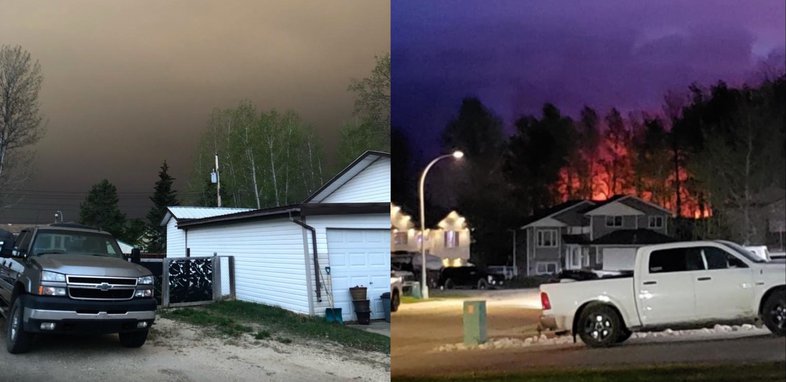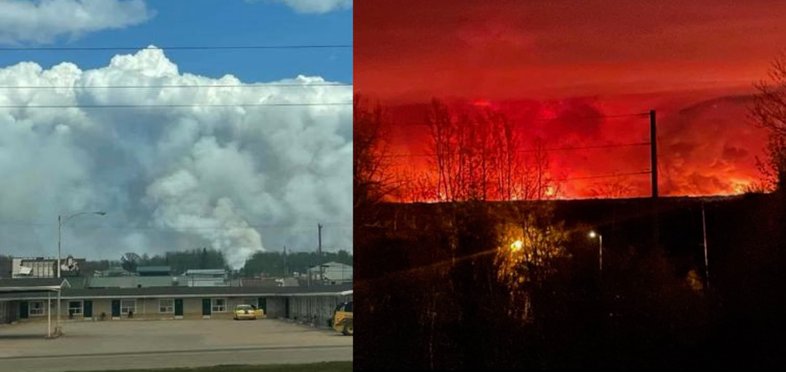Even as we head into the winter months, the memories of the wildfires that threatened our province earlier this year are still fresh, especially for the communities that were forced to evacuate. Fox Creek, Alberta – located approximately 260 km northwest of Edmonton – was one of those communities.
The wildfires that encroached on the community of Fox Creek in early May 2023 were terrifying for residents of the small town of approximately 2,000 people. It was especially worrying for the health professionals who care for the people in the community. Dr. Karin Corrigan, a family physician who has worked in Fox Creek for the past 13 years, recalls that the process of evacuating Fox Creek patients was stressful for everyone involved – particularly in the first few days.
“As the wildfire moved closer, we began planning for a possible evacuation,” she explains. They had hoped to make sure patients had the medications they needed and provide some direction on what to do if the town was evacuated, but things moved fast. “We reached out to the town to get a list of elderly and vulnerable people from a previous evacuation alert but discovered that our community resource centre had already contacted everybody and arranged transport for those who needed it.”

When Dr. Corrigan and her colleagues were given the order to evacuate the local hospital the next day, on May 6, a skeleton staff stayed to keep the ER open, and lab and housekeeping were instructed to close and leave. “We were told at 8:15 p.m. that we needed to leave the hospital and town while maintenance staff had to lock up and secure the facility. The fire was only 10 kilometres from town, so we had to move fast.”
Heading to safety and setting up a temporary clinic
Whitecourt, which is roughly 84 km southeast of Fox Creek, was the designated evacuation centre, and that’s where most of the community headed immediately, including many of the local physicians. Some colleagues in Edmonton reached out to offer places to stay, and a few physicians accepted the offer for the weekend to rest and prepare for the week ahead.
“On Monday morning, we had a meeting with the local physicians in Whitecourt and figured out processes.” As the physicians on call, Dr. Corrigan and her colleague Dr. Tania Cilliers needed to remain in Whitecourt and wanted to stay close in case residents were allowed to return to Fox Creek and the hospital had to be reopened. “One of our colleagues who lives in Whitecourt offered us accommodation and after we settled in, we started contacting patients who had clinic appointments. The next day we met as a group of physicians with our clinic staff, which included two MOAs and a practice nurse.” After that meeting, the decision was made to open a satellite clinic to care for patients. “We knew people through the primary care network and learned that a local clinic had exam rooms available because one of the physicians was away on holiday,” explains Dr. Corrigan. “They gave us equipment and space, so we were able to set up a temporary clinic to serve the patients that had made their way to Whitecourt.” Dr. Corrigan stresses that their MOAs and their practice nurse sacrificed time with their own families to ensure patients received the care they needed. “The Whitecourt physicians welcomed us and took on an extra workload, and the brand new PCN ED and local PCN office staff jumped right in and provided support.”
The McLeod River Primary Care Network, which serves her region, played a key role in ensuring continuity of care for patients. “They began posting updates on social media to keep patients informed and sent information to the Town of Fox Creek, so they could share it out, too.” Dr. Corrigan explains that the maintenance manager for the Fox Creek hospital had to travel there daily to check on the facility so was able to bring necessary medication and equipment back to the satellite clinic in Whitecourt as needed.
“Our practice nurse worked out of space in the PCN office and pulled contact information from the clinic panel to connect with our elderly and vulnerable patients.” They discovered one of their elderly patients needed a wheelchair and another needed oxygen, so the clinic arranged both. Some patients were getting low on medication, so the clinic worked with the Fox Creek pharmacy to transfer prescriptions. “In less than a week, we had our clinic up and running,” recalls Dr. Corrigan. “And most of our patients knew where to find us and get what they needed.” The local PCN also worked to connect evacuees with social workers, who offered information on available supports including counselling and financial programs.
By Monday, May 15, Dr. Corrigan and her colleagues had established a fully functioning clinic. “We were able to do wounds and biopsies and most of the other things we could do in our regular clinic.” The PCN transferred over calls, so they could also answer inquiries, book appointments and direct people to other resources as necessary. Not surprisingly, the demand on local services increased so, with the help of the local chief of staff and medical director, Dr. Corrigan secured hospital privileges and began working with Dr. Van Schalkwyk in the Whitecourt Health Care Centre ER in the afternoons to help with the extra load. “From the local ER to the local pharmacy, they did whatever needed to be done, so I was happy to help wherever I could,” recalls Dr. Corrigan.

Returning home and lessons learned
The evacuation order was lifted for Fox Creek on May 24, and people were allowed to return to the community, although the first few days were a bit chaotic. “They wanted the hospital to be up and running right away, but it takes time to set things back up.” Although health care professionals were allowed back into the community, they were not allowed to return to their houses. “We had to go straight to the hospital. One of the nurses came in but couldn’t go home to grab her uniform so had to come to the hospital in shorts.”
There were other frustrations as well. “Because of outages, the medical clinic didn't have a phone when we first returned. So on the first day, we couldn’t communicate with anyone. It took two days before the notice on the AHS website was updated that the hospital ER was open, so people didn’t know they could come to us. It was a bit of a hiccup after an otherwise pretty efficient process.”
When Dr. Corrigan reflects on the learnings from the evacuation experience, she notes that EMRs were a lifeline. “By the Monday after the evacuation, I was able to find patients and make sure they were getting the care they needed.” In the days that followed, one of the biggest needs that people had was for prescriptions because some of them just grabbed what they had. “The nice thing about electronic medical records was that they allowed us to transfer prescriptions wherever they were needed. For other patients, who needed biopsies or tests, we were able to connect with radiologists, neurologists, urologists and other specialists to arrange the care that was needed. Whatever we needed to know, we could find it. And that meant things didn’t grind to a halt because of the wildfire.”
Dr. Corrigan is especially grateful for the support from her physician colleagues, like Dr. Gerhard Olivier and Dr. Danie van Schalkwyk, who opened their homes to her and Dr. Cilliers. “It was a stressful time, but being able to visit at the end of a long day made such a difference.” She notes that Dr. Mareli Powell offered valuable guidance and logistical support during the entire process, even during her summer respite. “We simply couldn’t have managed without them. I’m still astounded by what we were able to do to take care of the patients and the community who needed us during such a difficult time.”
She also has high praise for the way the first responders worked to save the community from the two fires that firefighters dubbed “the Eagle Complex,” which at one point were only 1 km from the town. “They were amazing. And when we returned, emergency workers lined the road into town with signs saying, ‘Welcome back.’ It was so emotional.”
The lessons learned from this experience will ensure the community is prepared for whatever challenges they may face in the future. “Our patients, our team and the entire town were incredibly resilient and resourceful,” reflects Dr. Corrigan. “I think after this we could handle almost anything.”
Banner image credit: Chil Vera, Pixabay.com
